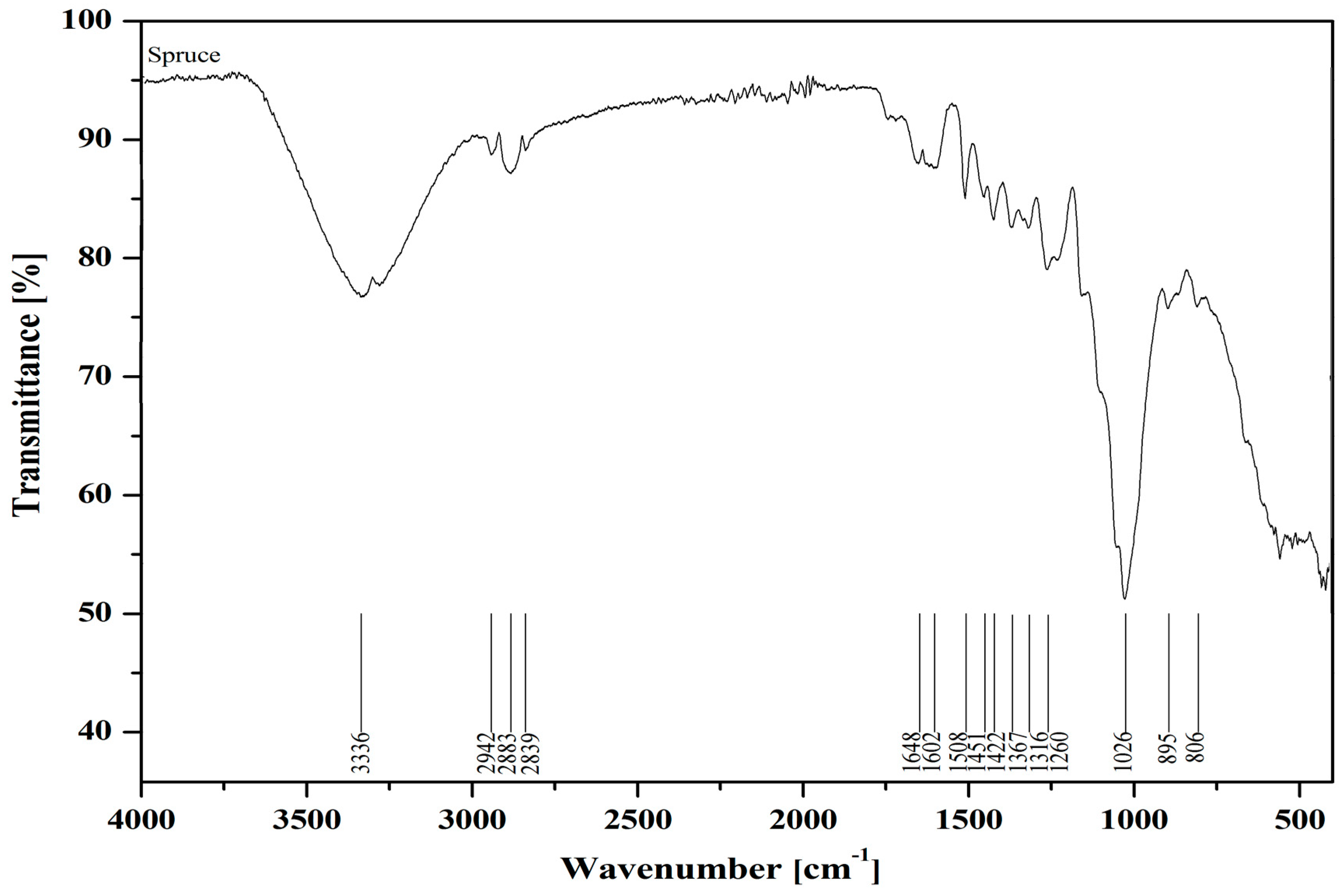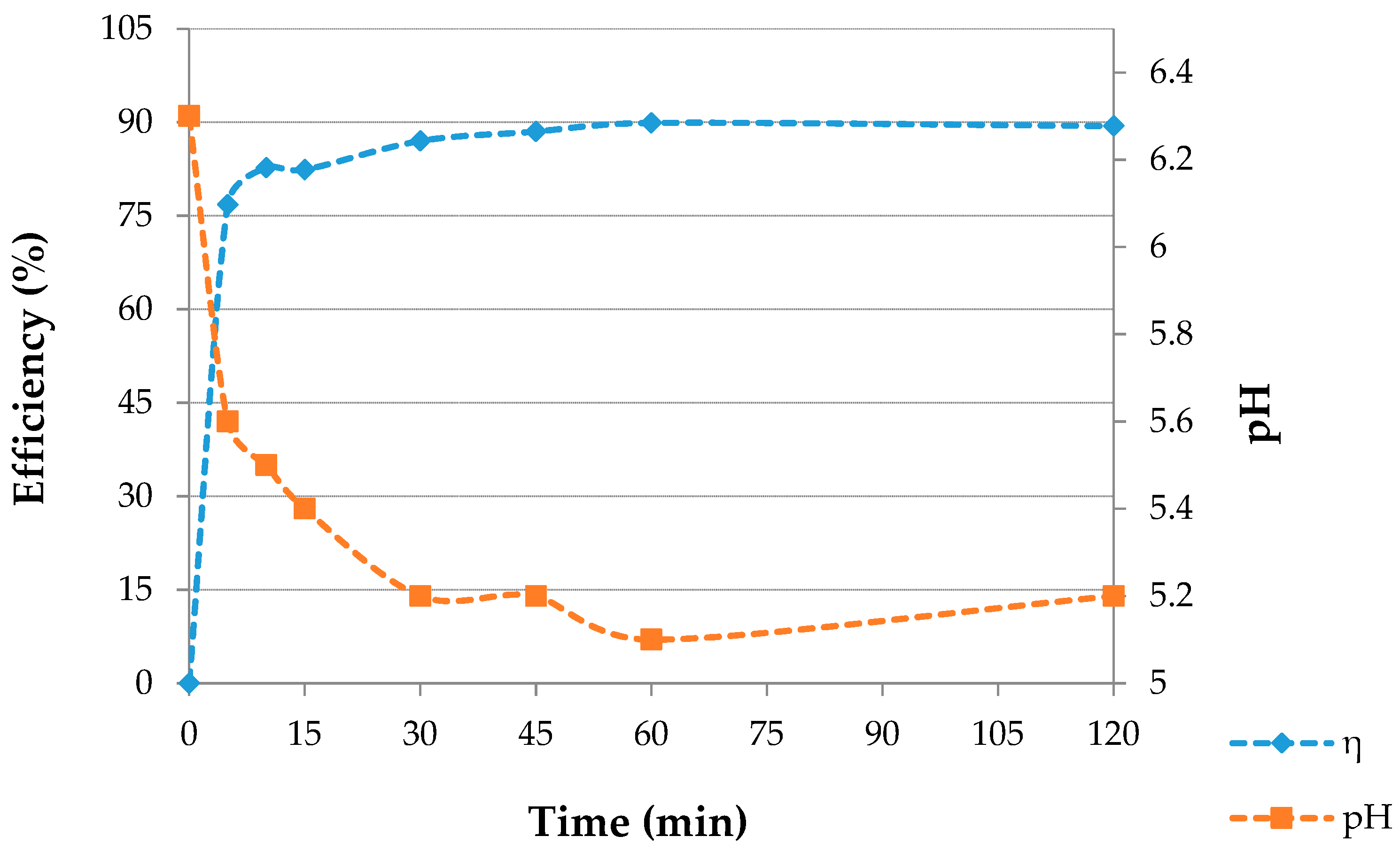Removal of Copper from Water Solutions by Adsorption on Spruce Sawdust †
Abstract
:1. Introduction
2. Materials and Methods
2.1. Adsorbent
2.2. Experiment Procedures
3. Results and Discussion
3.1. Infrared Sprectra
3.2. Sorption Experiments
4. Conclusions
Author Contributions
Acknowledgments
Conflicts of Interest
References
- Abdel-Raouf, M.S.; Abdul-Raheim, A.R.M. Removal of heavy metals from industrial waste water by biomass-based materials: A review. J. Pollut. Eff. Cont. 2017, 5, 1–13. [Google Scholar] [CrossRef]
- Al-Saydeh, S.A.; El-Naas, M.H.; Zaidi, S.J. Copper removal from industrial wastewater: A comprehensive review. J. Ind. Eng. Chem. 2017, 56, 35–44. [Google Scholar] [CrossRef]
- Ageena, N.A. The use of local sawdust as an adsorbent for the removal of copper ion from wastewater using fixed bed adsorption. Eng. Tech. J. 2010, 28, 224–235. [Google Scholar]
- Balintova, M.; Demcak, S.; Pagacova, B. A study of sorption heavy metals by natural organic sorbents. Environments 2016, 2, 189–194. [Google Scholar]
- Demcak, S.; Balintova, M.; Hurakova, M.; Frontasyeva, M.V.; Zinicovscaia, I.; Yushin, N. Utilization of poplar wood sawdust for heavy metals removal from model solutions. Nova Biotechnol. Chim. 2017, 16, 26–31. [Google Scholar] [CrossRef]
- Thapak, H.K.; Sharma, J.; Boudh, B.; Banger, N.; Dwivedia, P.; Thapak, H.K. Adsorption of copper ions in aqueous media using tea waste and sawdust as an adsorbent. Int. J. Innov. Res. Sci. Technol. 2015, 2, 52–57. [Google Scholar]
- Ince, M.; Ince, O.K. An Overview of Adsorption Technique for Heavy Metal Removal from Water/Wastewater: A Critical Review. Int. J. Pure Appl. Sci. 2017, 3, 10–19. [Google Scholar] [CrossRef]
- El-Saied, F.A.; Abo-Elenan, S.A.; El-shinawy, F.H. Removal of lead and copper ions from polluted aqueous solutions using nano-sawdust particles. Int. J. Waste Res. 2017, 7, 2–7. [Google Scholar] [CrossRef]
- Salamat, A.; Ainane, A.; Dahbi, L.; Khammour, F.; M’hamed Elkouali, T.A. Valorization the waste of the wood industry (sawdust) and their use as adsorbent material: Physicochemical characterization and modeling of optimization sorption using statistical approach. J. Mater. Environ. Sci. 2018, 9, 201–211. [Google Scholar] [CrossRef]
- Schwanninger, M.; Rodrigues, J.C.; Pereira, H.; Hinterstoisser, B. Effects of short-time vibratory ball milling on the shape of FT-IR spectra of wood and cellulose. Vib. Spectrosc. 2004, 36, 23–40. [Google Scholar] [CrossRef]
- Larous, S.; Meniai, A.-H.; Lehocine, M. Bencheikh. Experimental study of the removal of copper from aqueous solutions by adsorption using sawdust. Desalination 2005, 185, 483–490. [Google Scholar] [CrossRef]


Publisher’s Note: MDPI stays neutral with regard to jurisdictional claims in published maps and institutional affiliations. |
© 2019 by the authors. Licensee MDPI, Basel, Switzerland. This article is an open access article distributed under the terms and conditions of the Creative Commons Attribution (CC BY) license (https://creativecommons.org/licenses/by/4.0/).
Share and Cite
Kovacova, Z.; Demcak, S.; Balintova, M. Removal of Copper from Water Solutions by Adsorption on Spruce Sawdust. Proceedings 2019, 16, 52. https://doi.org/10.3390/proceedings2019016052
Kovacova Z, Demcak S, Balintova M. Removal of Copper from Water Solutions by Adsorption on Spruce Sawdust. Proceedings. 2019; 16(1):52. https://doi.org/10.3390/proceedings2019016052
Chicago/Turabian StyleKovacova, Zdenka, Stefan Demcak, and Magdalena Balintova. 2019. "Removal of Copper from Water Solutions by Adsorption on Spruce Sawdust" Proceedings 16, no. 1: 52. https://doi.org/10.3390/proceedings2019016052
APA StyleKovacova, Z., Demcak, S., & Balintova, M. (2019). Removal of Copper from Water Solutions by Adsorption on Spruce Sawdust. Proceedings, 16(1), 52. https://doi.org/10.3390/proceedings2019016052




